Using Enterprise Custom Fields from Microsoft Project for OnePager Live
Contents
- 1 About Using Enterprise Custom Fields
- 2 Logging-in to Your Microsoft Project Server Account from Microsoft Project Professional
- 3 Logging-in to Your Microsoft Project Server Account through the OnePager Pro Add-in
- 4 Accessing Your Microsoft Project Server’s Enterprise Custom Fields
- 5 Suspending the Use of Enterprise Custom Fields
- 6 Logging-in to Your Microsoft Project Server Account through the OnePager Pro Desktop
- 7 Accessing Your Microsoft Project Server’s Enterprise Custom Fields
About Using Enterprise Custom Fields
24.3.1-OPL2 7/12/2017
OnePager Pro (OPP) offers access to Microsoft Project Server’s Enterprise Custom Fields (ECF). You can use these fields to determine swimlanes, colors, flagging of tasks, and other properties.
This article covers how to log-in to your Microsoft Project Server accounts and how to access your ECF data through OPP's Template Properties form.
Logging-in to Your Microsoft Project Server Account from Microsoft Project Professional
You can always log-in to your Microsoft Project Server account from Microsoft Project. Once you are logged-in, you can follow the steps below from that point, where OPP is launched, and access the Template Properties form to access your ECF data.
Logging-in to Your Microsoft Project Server Account through the OnePager Pro Add-in
Logging-in to your Microsoft Project Server Account can also be done directly from the OPP Add-in application.
1) Launch Microsoft Project Professional and load the Microsoft Project source plan desired from its storage location.
2) Click the Template Properties button on the Microsoft Project Add-in tab which brings up the OPP Template Properties form shown below:
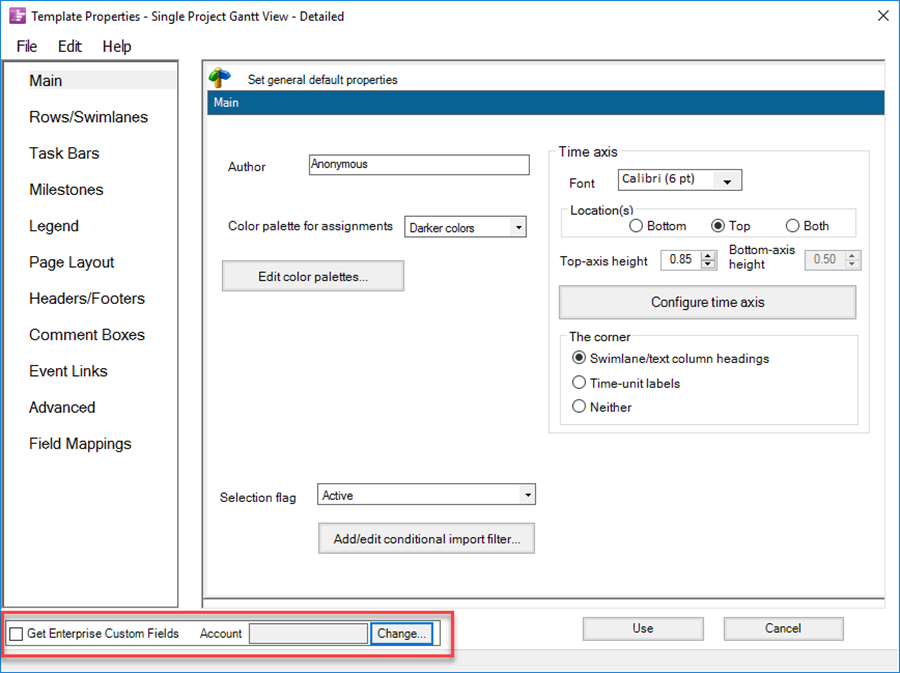
3) The bottom of the form above contains the Get Enterprise Custom Fields checkbox and a window used in conjunction with the Change button that allows you to access and manage your Microsoft Project Server Accounts.
4) This method does not apply when using the OPP Desktop application.
Accessing Your Microsoft Project Server’s Enterprise Custom Fields
5) When you check the Get Enterprise Custom Fields checkbox, OnePager will check to see if it is already logged-in to your Microsoft Project Server account. If so, the ECF data will be loaded into the Template Properties form’s dropdown list of fields as shown below:
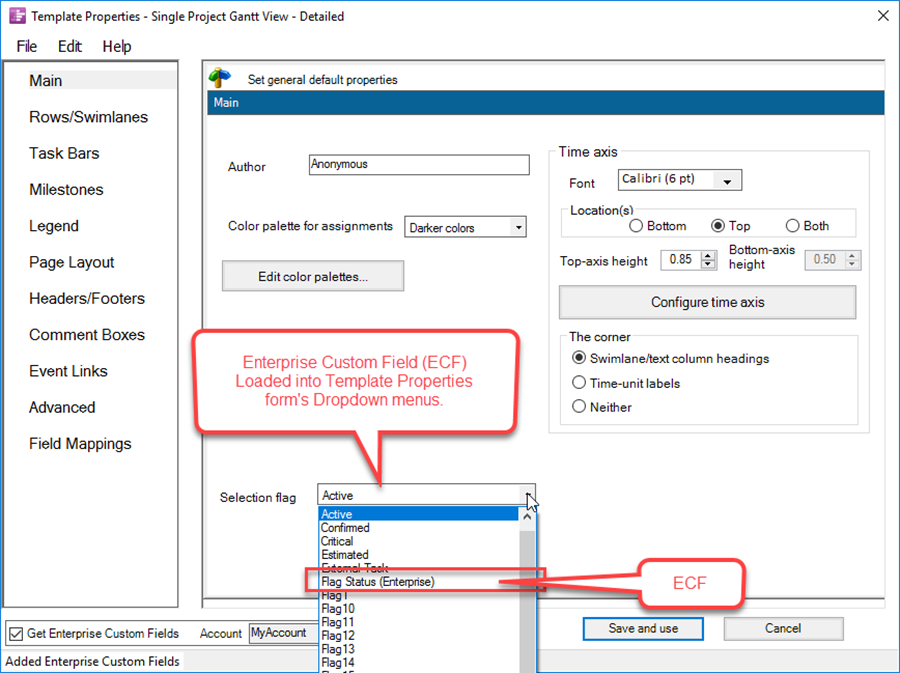
6) If OnePager is not already logged-in, OPP Add-in attempts to log-in using the URL for whatever Microsoft Project Server account Microsoft Project is connected to.
- a) If OnePager finds that Microsoft Windows has stored default credentials for Microsoft Project to log-in to Microsoft Project Server, OnePager will attempt to use these without prompting you and without ever actually knowing the username and password.
- b) If successful, OnePager will create a OnePager log-in account with just the URL but with no username and password.
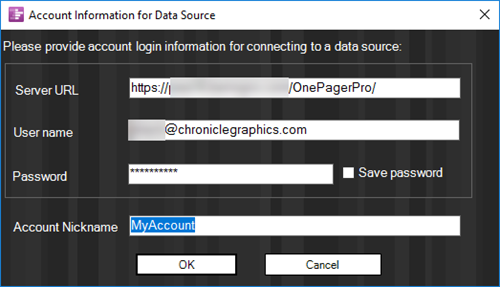
7) Once OnePager connects to your Microsoft Project Server server account, it retrieves the ECF data, and displays a success message, Added Enterprise Custom Fields, as shown here:
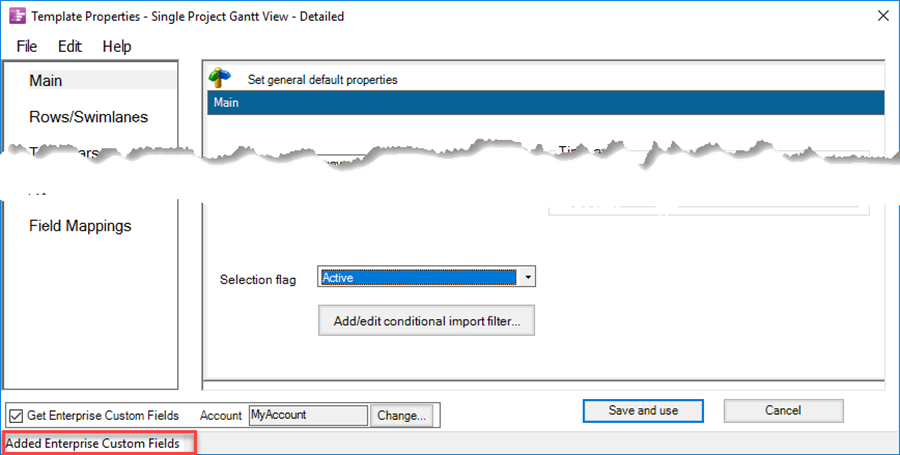
8) The ECF data are now loaded into the dropdown lists as shown above.
9) You can now select the ECF for various purposes such as for controlling rows/swimlane organization, selection of task/milestone colors, or Field Mappings selections on the Template Properties form's Advanced tab.
10) When you click the Save and use button, the action makes the Template with the ECF data the current Template. It now can be used to create a NEW project view or UPDATE/OPEN an existing one.
11) When a new project view is created using the desired ECF information, you can open the project view, access the Project-View Properties (PVP) form, and make changes to the row/swimlane organization as described above by selecting the desired ECF now available.
12) As a note, other ECF’s will not be available to you unless you already included them in some mapping in the original Template. Please see the Field Mappings Tab discussion in the referenced article for more information and suggestions: Template Only Features for OnePager Pro .
13) A similar approach using the OPP Add-in application may be used to UPDATE a project view build with ECF’s. The note in the previous paragraph also applies.
Suspending the Use of Enterprise Custom Fields
14) To suspend the use of Enterprise Custom Fields, uncheck the Get Enterprise Custom Fields checkbox and click Save and use.
15) This action will remove the ECF’s from the Template Properties form's dropdown lists so that creating and updating project views can take place with these Templates without the ECF’s.
Logging-in to Your Microsoft Project Server Account through the OnePager Pro Desktop
Logging-in to your Microsoft Project Server Account can also be done from the OPP Desktop application as well as the Add-in application. To do this, please use the following steps:
1) Launch OPP from the Desktop icon.
2) The log-in is performed in the Template Properties form.
- a) You can access the Template Properties form for the OPP Desktop application by clicking the File tab on the ribbon and then clicking the Options tab.
- b) This will bring up the OnePager Options page where you’ll find the Template button in the lower right of the page.
- c) Clicking the Template button which will bring up the Template Properties form shown below:

Accessing Your Microsoft Project Server’s Enterprise Custom Fields
3) Now, check the Get Enterprise Custom Fields checkbox and the OPP Desktop application will bring up the log-in form shown below:

4) Once you enter your credentials, click the OK button to attempt the connection.
5) The OPP Desktop application will log into your account and download your ECF information into the Template Properties form’s dropdown lists as shown below:
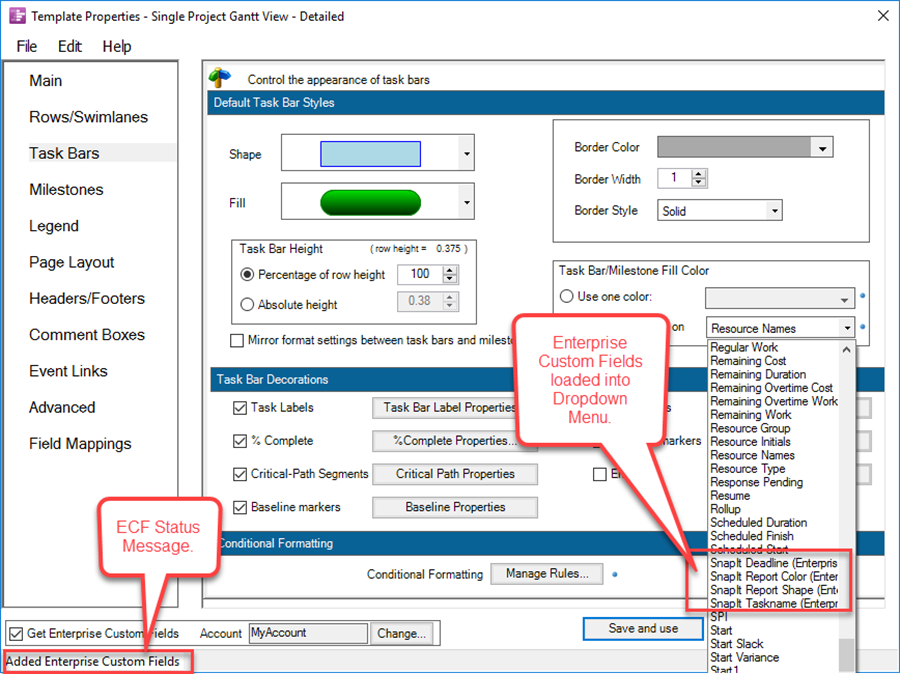
6) When the OPP Desktop application is launched and running, Microsoft Project is not running so it is not possible to connect to your Microsoft Project Server account through Microsoft Project.
7) If the OPP Desktop application is not able to connect to the Microsoft Project Server you’ve requested, a message will appear at the bottom of the Template Properties form as shown below:
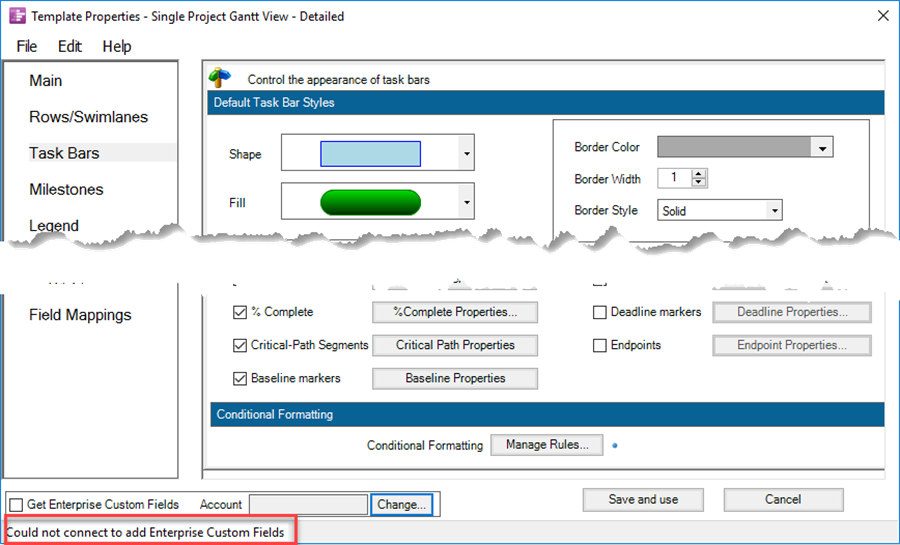
8) Once you are logged-in to your Microsoft Project Server account through the OPP Desktop application, all features and functions with respect to ECF are available as if you were using the OPP Add-in application
(24.3.1-OPL2)